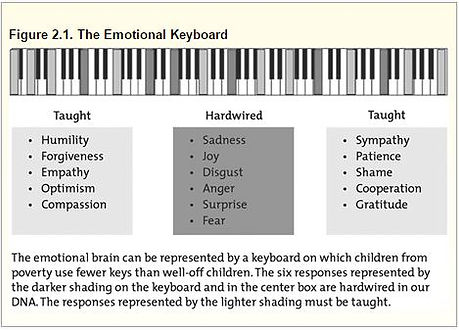
The Neuroscience
The biology and physiology of poverty must be understood to improve our understanding of our students' potential strengths and weaknesses.
(Please view the adjacent video How Poverty Changes the Brain (4:13) before continuing.)

In Eric Jensen’s (2009) book, Teaching with Poverty in Mind, he reminds us that children in poverty are faced with daily challenges that are often overwhelming, and these challenges they face are likely ones that affluent children may never have to confront.
There are significant risks factors that affect these less-advantaged children’s school experiences, their academic success, and their social interactions:
ACRONYM: EACH
Emotional and Social Challenges.
-
Acute and Chronic Stressors.
-
Cognitive Lags.
-
Health and Safety Issues.
Jensen (2009) notes that understanding these deficits will help educators recognize behaviour patterns that emerge as characteristics of impoverished children and youth:
-
"Acting-out” behaviors.
-
Impatience and impulsivity.
-
Gaps in politeness and social graces.
-
A more limited range of behavioral responses.
-
Inappropriate emotional responses.
-
Less empathy for others' misfortunes.
It can be easy to misinterpret emotional and social deficits as a lack of respect or manners. Jensen suggests that "it is more accurate and helpful to understand that the students come to school with a narrower range of appropriate emotional responses than we expect. The truth is that many children simply don't have the repertoire of necessary responses. It is as though their brains' "emotional keyboards” play only a few notes"
Education Canada Online suggest some important findings be considered.
Risk factors associated with poverty have been shown to impact:
-
children’s school readiness
-
academic achievement
-
behavioural and cognitive capabilities
Recently, interest in the neurological effects of poverty on children’s academic learning has been growing, and researchers are finding associations between SES and areas of the brain responsible for:
-
attention and focus - filter systems can vary
-
inhibitory self-regulation
-
language development
The effects of stress on the brain have also been associated with low SES thus posing a threat for children’s learning.
IMPORTANT NOTE:
"Not all children living in poverty or in a low-SES family will suffer negative outcomes or be stressed and unhappy, and SES is not a neurological condition that can be directly mapped onto genetic predispositions." (Education Canada)
The Value of Empathy
It becomes so important to recognize that the conditions of impoverished children's lives may have led to cognitive learning styles that compensate for difficulties such as:
-
filtering out irrelevant information
-
remembering factual information
-
emotional impulse control